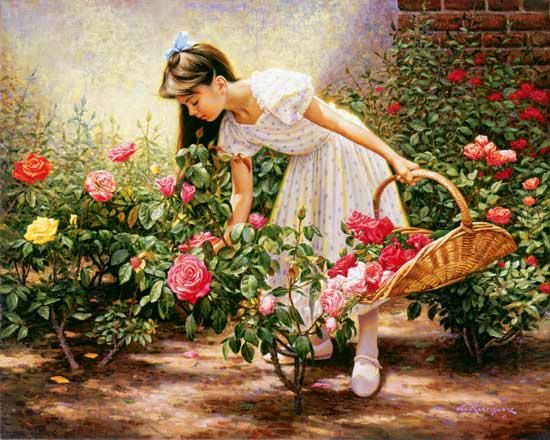
In Hilda Conkling’s Poems by a Little Girl, two poems are devoted to rose petals, hinting at love. Both were written between the ages of seven and nine.
In the first poem, rose petals are associated with “my heart”:
ROSE-PETAL
by Hilda Conkling
PETAL with rosy cheeks,
Petal with thoughts of your own,
Petal of my crimson-white flower out of June,
Little petal of my heart!
In the second poem, rose petals are associated with love and a grey dove:
PINK ROSE-PETALS
by Hilda Conkling
PINK rose-petals
Fluttering down in hosts,
I know what you mean
Sometimes, in Spring.
It is love you mean.
Love has a gray bird
That flutters down;
A dove that comes flying
Saying the same thing.
How happy it makes me to think of it,
Rose-petals . . . the gray dove . . .
In post-biblical Judaism, the bird, in particular the dove, symbolises the human soul. On the other hand, Christianity represents the Holy Spirit as a dove (but generally a white one). Here again we see the rose linked to spiritual love, but since the dove is grey, it is not driven by physical beauty.
In a previous post, I presented and analysed the poem “After Plotinus” by Fabian Strachan Woodley. It tells of a “perfect, new blown rose” lost by a little flower-girl; four people, “souls blind and dull,” ignored it, but a fifth person “raised it, and bore it tenderly;” although “there was no beauty in the rose,” he “saw mirrored in the flower his own Mind Beautiful.” I explained that the rose has for a long time symbolised both love and secrecy, and since the title of the poem refers to the Neo-Platonician philosopher Plotinus, it deals probably with the love for spiritual beauty.
The website devoted to Woodley quotes him saying:
The bird of the morning only knoweth the worth of the book of the rose; for not everyone who readeth the page understandeth the meaning.
Indeed, in an epoch more and more dominated by sharp images and superficial ideas, many people will take the words of such poems in a straightforward way, without looking for a hidden meaning.
Source of the poems: Hilda Conkling, Poems by a Little Girl (1920). Electronic version available on Fullbooks.com and Project Gutenberg. Checked with the digitisation of the original edition on Internet Archive.
This is a revised version of a post previously published on Agapeta, 2015/12/16.

